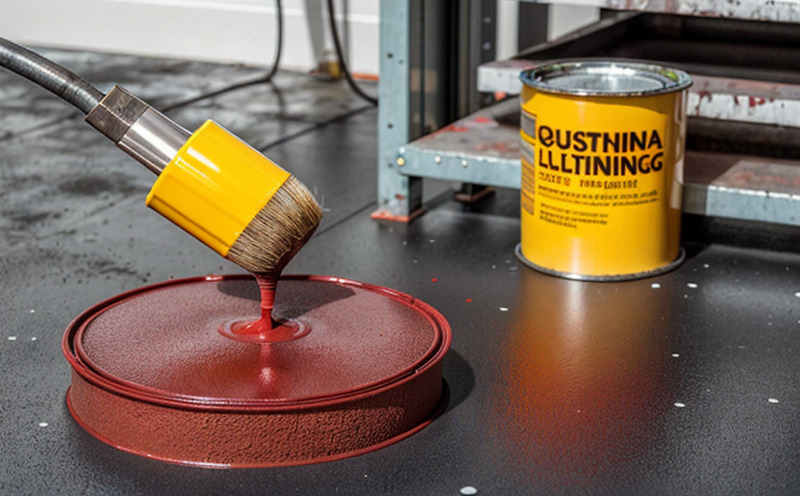ISO 16474 UV Weathering Resistance Testing of Paints
The International Organization for Standardization (ISO) 16474 specifies a procedure to determine the resistance of paints and coatings to ultraviolet (UV) radiation. This testing is critical in industrial manufacturing, especially when dealing with exterior paints that are exposed to harsh environmental conditions such as sunlight, rain, and temperature fluctuations.
The ISO 16474 test simulates accelerated weathering using UV lamps, artificial light sources, or a combination of both. The exposure provides an assessment of the durability of paint coatings under conditions that simulate outdoor weathering for extended periods in a short time frame. This ensures that paints and coatings can withstand environmental stresses without compromising their integrity.
The test is particularly important for sectors such as automotive manufacturing, construction, and aerospace, where the longevity of exposed surfaces is paramount. By adhering to this standard, manufacturers can ensure that their products meet stringent quality and durability requirements, thereby maintaining a competitive edge in the market.
During testing, various factors are considered, including the type of UV lamp used (e.g., xenon-arc lamps), the exposure duration, the temperature conditions, and even humidity levels. The test can be customized to simulate specific environmental conditions relevant to the intended use of the paint or coating.
The process involves exposing a small specimen of the paint or coating to controlled UV radiation for extended periods. This is followed by visual inspection and measurement of any changes in color, gloss, adhesion, or other properties that might indicate degradation. The results are compared against pre-established acceptance criteria to determine compliance with ISO 16474.
This testing method allows manufacturers to identify potential issues early on and make necessary adjustments to improve product performance before full-scale production begins. It also provides a reliable means of quality control, ensuring that the final products meet the required standards for durability and longevity.
The importance of ISO 16474 UV weathering resistance testing cannot be overstated in industries where exterior surfaces are exposed to severe weather conditions. By using this standard, manufacturers can ensure their paints and coatings will perform reliably under real-world conditions, enhancing product quality and customer satisfaction.
Benefits
The ISO 16474 UV weathering resistance test offers a reliable method for assessing the durability of paints and coatings exposed to outdoor environmental factors.
This testing ensures that products meet stringent quality and longevity requirements, enhancing customer satisfaction and brand reputation.
By identifying potential issues early in the development process, manufacturers can optimize their product design and improve overall performance.
The results of this test provide a robust basis for quality control and compliance with industry standards.
The ISO 16474 UV weathering resistance testing method is invaluable in ensuring that paints and coatings can withstand the rigors of outdoor conditions, thereby extending their useful life and maintaining performance levels. This not only benefits manufacturers but also contributes to more sustainable manufacturing practices by reducing waste and promoting efficient use of resources.
Industry Applications
Automotive Manufacturing: Ensuring that exterior paint finishes on vehicles can withstand the harsh conditions encountered during everyday use.
Construction Industry: Evaluating the durability of paints and coatings used in building exteriors to ensure longevity against environmental elements.
Aerospace Sector: Testing the resilience of paints and coatings on aircraft surfaces, which are exposed to extreme weather conditions.
The versatility of ISO 16474 UV weathering resistance testing makes it applicable across various industries where outdoor exposure is a significant factor. By simulating real-world conditions in an accelerated manner, this test provides valuable insights into the performance of paints and coatings under diverse environmental stressors.
Use Cases and Application Examples
The ISO 16474 UV weathering resistance testing is a cornerstone for ensuring paint durability in several industrial applications. For instance, automotive manufacturers can use this test to verify that the exterior paints of their vehicles will remain vibrant and undamaged even after prolonged exposure to sunlight and other environmental factors.
In construction, builders often face challenges when selecting paints and coatings for exterior walls or roofing materials. The ISO 16474 UV weathering resistance test helps in selecting products that can withstand the rigors of outdoor conditions over extended periods.
The aerospace industry also benefits greatly from this testing method as it ensures that aircraft surfaces, including the paint on wings and fuselage, can endure extreme environmental conditions without degradation. This is crucial for maintaining safety standards and ensuring the longevity of these critical components.
These use cases highlight how ISO 16474 UV weathering resistance testing plays a vital role in enhancing product quality and reliability across various sectors, thereby contributing to more sustainable manufacturing practices.





